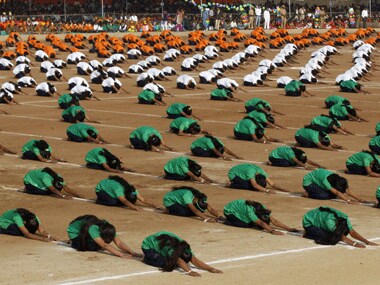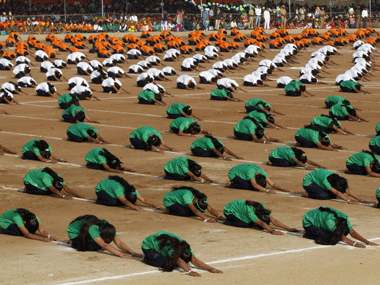Don’t take yoga out of schools. Take religion and politics out of yoga. Treat yoga as sport, a recreational activity that adds value to life, strength to muscles and stamina to lungs. Don’t look for god in it; search instead for a healthier lifestyle. Prime Minister Narendra Modi’s efforts to popularise yoga globally, his own messianic zeal to become its brand ambassador is a welcome decision, unless it turns out to be a photo-op like the Swacch Bharat campaign or gives the Hindutva brigade a reason to hail it as a triumph of their great ancient culture. [caption id=“attachment_2279784” align=“alignleft” width=“380”]
 Representational image. Reuters[/caption] Yoga in schools is a great, though not novel, idea. It is a healthy prescription for children used to sedentary lives, stress of competition and pollution in the environment. Just as students are expected to study pre-decided subjects, at pre-decided hours, there is no harm in making yogic postures and breathing exercises part of the curriculum, at least for those who are medically fit for them. The benefits of yogic postures, breathing techniques and meditation are well-documented.
Several studies have shown that
yoga strengthens the musculoskeletal system, improves lung function, helps people with asthma and improves concentration. For schoolgoing children, these are priceless gains. So, what is the problem people have with yoga, or sending children to school for celebrating International Yoga Day (21 June )? The crux of the problem lies in linking yoga to religion, treating it as an extension of a religious philosophy. “Yoga may have many health benefits, but observing International Yoga Day in schools should not be made compulsory. The order is undemocratic and amounts to infringing on the rights of a group of citizens who don’t worship anyone except Allah who is formless and omnipresent,” says Dr Zahir Kazi, president of Anjuman-I-Islam, which runs a chain of schools and professional colleges in Maharashta. His organisation is opposing the decision to make the 21 June celebrations mandatory. Yoga and Islamic organisations have often been at loggerheads. A few years ago, a Malaysian organisation issued a fatwa against yoga, saying elements of Hinduism in the ancient Indian exercise could corrupt them. A similar edict was issued by organisations in some other countries, including Indonesia, where yoga is quite popular. But practitioners of yoga reacted by saying the fatwa will not deter them. It is true that yoga’s origin is linked to Hindu scriptures and rituals. Some people suggest that it may have arisen from postures and breathing techniques practiced by Vedic ascetics who performed yajnas (sacrificial rituals). There are several references to yoga in the Upnishads and the book of peace of the Mahabharata But yoga has evolved over the years — picking up concepts from other faiths and countries — to become a secular practice, with disciples in several countries. It is no longer a religious philosophy, but a form of exercise that involves stretching, strengthening, breathing and concentrating. Followers of other faiths have stripped yoga of its religious meaning by practicing just it exercises, renaming them and omitting the chants that link it to Hindu scriptures. Just like Kung Fu, which is believed to have originated in Buddhist Shaolin temples, it has transcended religious and cultural barriers. A US court recently ruled, yoga doesn’t belong to any particular religion. “It is clear that while yoga may be practiced for religious reasons, it cannot be said to be inherently religious or overtly sectarian,” the court said, settling a petition challenging the decision of a US school to teach yogic exercises. In the US, more than 25 million people practice yoga. Even the Arab world has embraced yoga. Several centuries ago, Persian Muslim scholar Al-Biruni (973-1048) had translated Patanjali’s Yoga Sutra into Arabic, introducing the region to the Indian concept. Today, it is estimated, Iran has nearly 200 yoga centres where Muslims, including some clerics, practice its postures and breathing techniques. A few years ago, some hardliners had sought a ban on yoga in Iran, saying it was a threat to Islam. But the opponents soon ran out of arguments as yoga continued to thrive. Farida Hamza,
avid blogger and yoga teacher
, argues that instead of being anti-Islam, yoga has many things common with the religion. “A lot of people don’t realise this but if you look at the Muslim prayer, the actual routine, it is very similar to yogic poses. It has the mountain pose, hero’s pose, forward bend, child’s pose and a hand mudra. To someone like me, there are many similarities between these two deeply spiritual practices and I find a natural flow and balance in living as a Muslim yogi." “I am NOT saying that Islam came from yoga, or vice versa, I am simply saying that yogis and Muslims are more alike than people realize,”
she says in her blog
. Yoga was always a part of schooling. I remember yoga being taught every morning first at most of the schools I attended — including a Missionary School and a Kendriya Vidyala. Back then, it was seen as just another drill that students went through during the sports period. The debate around the religious connotation of yoga is a recent Indian phenomenon. Modi is doing children a great favour by taking yoga back to school. He just needs to ensure that it is implemented as a secular, holistic programme for mind, body and soul instead of a religious philosophy.
Representational image. Reuters[/caption] Yoga in schools is a great, though not novel, idea. It is a healthy prescription for children used to sedentary lives, stress of competition and pollution in the environment. Just as students are expected to study pre-decided subjects, at pre-decided hours, there is no harm in making yogic postures and breathing exercises part of the curriculum, at least for those who are medically fit for them. The benefits of yogic postures, breathing techniques and meditation are well-documented.
Several studies have shown that
yoga strengthens the musculoskeletal system, improves lung function, helps people with asthma and improves concentration. For schoolgoing children, these are priceless gains. So, what is the problem people have with yoga, or sending children to school for celebrating International Yoga Day (21 June )? The crux of the problem lies in linking yoga to religion, treating it as an extension of a religious philosophy. “Yoga may have many health benefits, but observing International Yoga Day in schools should not be made compulsory. The order is undemocratic and amounts to infringing on the rights of a group of citizens who don’t worship anyone except Allah who is formless and omnipresent,” says Dr Zahir Kazi, president of Anjuman-I-Islam, which runs a chain of schools and professional colleges in Maharashta. His organisation is opposing the decision to make the 21 June celebrations mandatory. Yoga and Islamic organisations have often been at loggerheads. A few years ago, a Malaysian organisation issued a fatwa against yoga, saying elements of Hinduism in the ancient Indian exercise could corrupt them. A similar edict was issued by organisations in some other countries, including Indonesia, where yoga is quite popular. But practitioners of yoga reacted by saying the fatwa will not deter them. It is true that yoga’s origin is linked to Hindu scriptures and rituals. Some people suggest that it may have arisen from postures and breathing techniques practiced by Vedic ascetics who performed yajnas (sacrificial rituals). There are several references to yoga in the Upnishads and the book of peace of the Mahabharata But yoga has evolved over the years — picking up concepts from other faiths and countries — to become a secular practice, with disciples in several countries. It is no longer a religious philosophy, but a form of exercise that involves stretching, strengthening, breathing and concentrating. Followers of other faiths have stripped yoga of its religious meaning by practicing just it exercises, renaming them and omitting the chants that link it to Hindu scriptures. Just like Kung Fu, which is believed to have originated in Buddhist Shaolin temples, it has transcended religious and cultural barriers. A US court recently ruled, yoga doesn’t belong to any particular religion. “It is clear that while yoga may be practiced for religious reasons, it cannot be said to be inherently religious or overtly sectarian,” the court said, settling a petition challenging the decision of a US school to teach yogic exercises. In the US, more than 25 million people practice yoga. Even the Arab world has embraced yoga. Several centuries ago, Persian Muslim scholar Al-Biruni (973-1048) had translated Patanjali’s Yoga Sutra into Arabic, introducing the region to the Indian concept. Today, it is estimated, Iran has nearly 200 yoga centres where Muslims, including some clerics, practice its postures and breathing techniques. A few years ago, some hardliners had sought a ban on yoga in Iran, saying it was a threat to Islam. But the opponents soon ran out of arguments as yoga continued to thrive. Farida Hamza,
avid blogger and yoga teacher
, argues that instead of being anti-Islam, yoga has many things common with the religion. “A lot of people don’t realise this but if you look at the Muslim prayer, the actual routine, it is very similar to yogic poses. It has the mountain pose, hero’s pose, forward bend, child’s pose and a hand mudra. To someone like me, there are many similarities between these two deeply spiritual practices and I find a natural flow and balance in living as a Muslim yogi." “I am NOT saying that Islam came from yoga, or vice versa, I am simply saying that yogis and Muslims are more alike than people realize,”
she says in her blog
. Yoga was always a part of schooling. I remember yoga being taught every morning first at most of the schools I attended — including a Missionary School and a Kendriya Vidyala. Back then, it was seen as just another drill that students went through during the sports period. The debate around the religious connotation of yoga is a recent Indian phenomenon. Modi is doing children a great favour by taking yoga back to school. He just needs to ensure that it is implemented as a secular, holistic programme for mind, body and soul instead of a religious philosophy.
Modi's International Yoga Day plan: Great idea but keep Hinduism out of it
Sandipan Sharma
• June 5, 2015, 07:14:51 IST
Yoga in schools is a great, though not novel, idea. It is a healthy prescription for children used to sedentary lives, stress of competition and pollution in the environment. Just as students are expected to study pre-decided subjects, at pre-decided hours, there is no harm in making yogic postures and breathing exercises part of the curriculum, at least for those who are medically fit for them.
Advertisement
)
End of Article